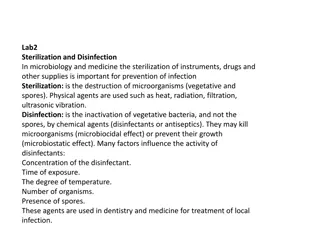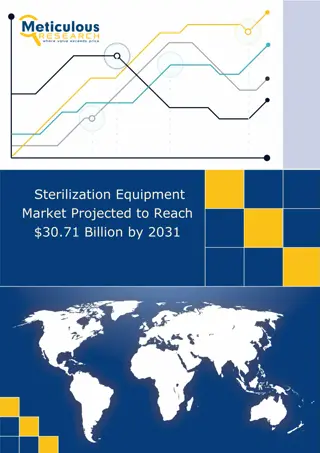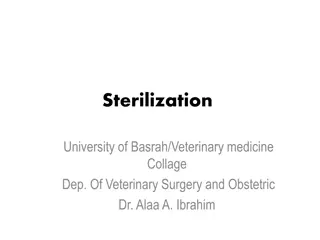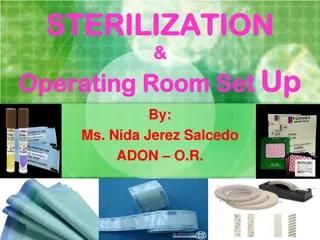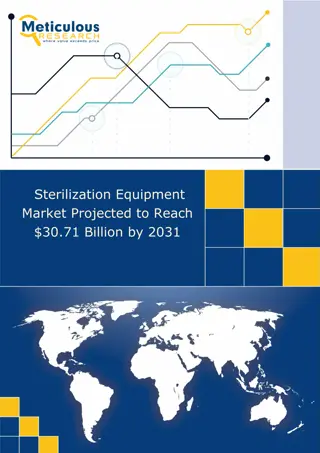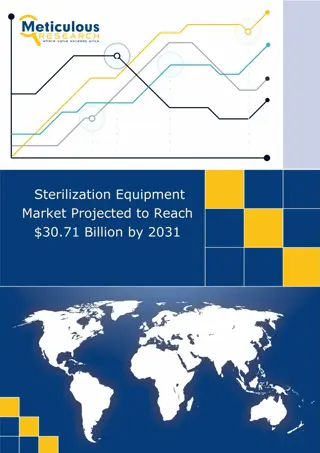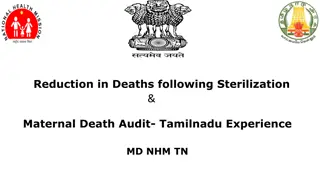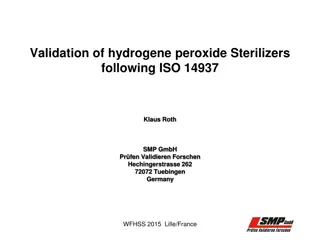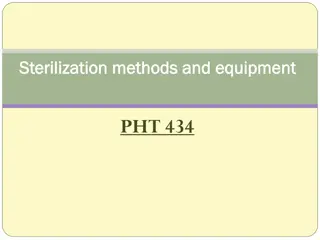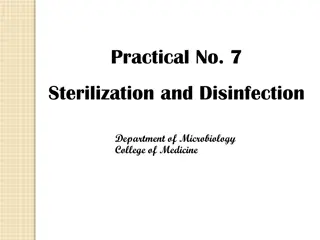Sterilization Methods: Hot Air Oven vs. Autoclave
Hot air oven, also known as a dry heat sterilizer, is widely used for sterilizing glassware, surgical instruments, and chemicals by maintaining a temperature of 160°C for 2 hours. Precautions include avoiding overloading, ensuring proper air circulation, and allowing adequate cooling time. Sterilization control involves using biological indicators like Bacillus atrophaeus spores. In contrast, an autoclave utilizes steam under pressure to sterilize various items at specific temperatures and pressures. It is commonly used for surgical instruments, culture media, plastic containers, and more.
Download Presentation

Please find below an Image/Link to download the presentation.
The content on the website is provided AS IS for your information and personal use only. It may not be sold, licensed, or shared on other websites without obtaining consent from the author.If you encounter any issues during the download, it is possible that the publisher has removed the file from their server.
You are allowed to download the files provided on this website for personal or commercial use, subject to the condition that they are used lawfully. All files are the property of their respective owners.
The content on the website is provided AS IS for your information and personal use only. It may not be sold, licensed, or shared on other websites without obtaining consent from the author.
E N D
Presentation Transcript
Hot air oven (Dry heat Sterilizer) Most widely used method of sterilization by dry heat. It is electrically heated and is fitted with a fan to ensure adequate and even distribution of hot air in the chamber. It is also fitted with a thermostat which maintains the chamber air at a chosen temperature. Holding temperature and time of 160 C for 2 hours.
Hot air oven (Dry heat Sterilizer) Materials sterilized: o Glassware - syringes, petri dishes, flasks, pipettes and test tubes. o Surgical instruments - scalpels, forceps, etc. o Chemicals such as liquid paraffin, fats, glycerol, oil, and glove powder, etc.
Hot air oven - precautions Overloading of hot air oven should be avoided. Material should be arranged in a manner so that free circulation of air is maintained. Material to be sterilized should be dried completely. Cotton plugs should be used to close the mouths of test tubes, flasks, etc. Paper wrapping of the items should be done. Any inflammable material like rubber (except silicone rubber) should not be kept inside the oven. Oven must be allowed to cool for two hours before opening the doors, since the glassware may crack by sudden cooling.
Hot air oven - Sterilization control Biological indicator: Spores (106) o Bacillus atrophaeus - to check the effectiveness of sterilization by dry heat. Earlier, non-toxigenic strain of Clostridium tetani was used. o Spores should be destroyed if the sterilization is done properly. Physical control: For example, digital displays on the equipment displaying temperature and time.
Autoclave Autoclave comprises of three parts Pressure chamber Lid Electrical heater.
Horizontal autoclave and Vertical autoclave
Sterilization Conditions Autoclave can be set to provide higher temperatures by adjusting the pressure provided to the vessel. o 121 C for 15 minutes at pressure of 15 lbs psi. o 126 C for 10 minutes at pressure of 20 psi. o 133 C for 3 minutes at pressure of 30 psi.
Uses of Autoclave Surgical instruments Culture media Autoclavable plastic containers Plastic tubes and pipette tips Solutions and water Biohazardous waste Glassware (autoclave resistible).
Precautions to be taken Autoclave should not be used for sterilizing waterproof materials Materials are loaded in such a way that it allows efficient steam penetration (do not overfill the chamber) Material should not touch the sides or top of the chamber Clean items and the wastes should be autoclaved separately olyethylene trays should not be used as they may melt and cause damage to the autoclave.
Types of Autoclaves Gravity displacement type autoclave: most commonly used. Positive pressure displacement type autoclave Negative pressure (vacuum) displacement type.
Sterilization control Biological indicator: Spores of Geobacillus stearothermophilus (formerly called Bacillus stearothermophilus). Spores are killed in 12 minutes at 121 C Chemical indicators o Class I - external pack control, (e.g. autoclave tape) o Class II - equipment control (Bowie-Dick test) o Class IV/V - internal pack control. Physical control: For example, digital displays on the equipment displaying temperature, time and pressure.
References Textbook of Medical Microbiology by Ananthnarayan, Paniker Textbook of Medical Microbiology by C.P Baweja Textbook of Medical Microbiology by S. Bhat, A.S.Sastry Textbook of Medical Microbiology by D.R.Arora, Brij bala Arora








